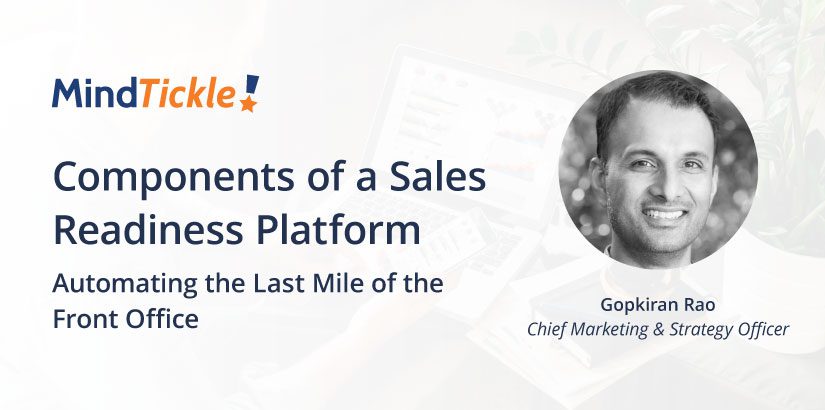In search of greater levels of sales efficiency and customer engagement, organizations have spent the last 20 years implementing myriad new technologies. Many of these technologies focus on automating marketing functions or sales operations — CRM, sales activity management, forecasting, customer service success management, contract management systems, and more. All of which are designed to improve marketing’s ability to connect with prospects, or the productivity and effectiveness of sales reps, as well as the quality of data that is passed to the back office.
However, despite this influx of productivity tools, one area that remains largely unaddressed is enabling and continuously improving great person-to-person interactions between an organization and its customers. Ideally, all customer-facing employees should have the skills, knowledge, and behaviors to deliver positive and engaging customer experiences. While every company prioritizes and strives to make progress toward this goal, readiness initiatives have largely been disjointed and siloed. For example, sales enablement, sales training teams and product marketers have been tasked with providing sales with the information, tools and content to help them sell more effectively. Additionally, learning and development departments have focused on improving job performance broadly across an organization.
But most organizations still have no systematic, repeatable, and measurable way to prepare and assess customer-facing employees’ ability to deliver an exceptional customer experience. They don’t have a framework in place to automate and proactively measure their customer-engagement knowledge and soft skills — a system that surfaces the right set of quantifiable behaviors and capability data points. This is where a Sales Readiness platform enters the picture enabling reps to best utilize available sales enablement content and materials and automating this last mile of the front office.
Sales Readiness Systems: Data-Driven, Automated Capabilities Evaluation
The goal of a Sales Readiness platform is to evaluate how capable a customer-facing employee is at engaging a customer or prospect and driving the conversation towards a specific outcome. And similarly, answering the questions of what a rep is capable of selling and their ability to up-sell, cross-sell or reach a quota. It helps to ensure that each rep has the optimal mix of knowledge, skills and behaviors to be engaging and deliver an exceptional customer experience throughout the buying journey.
Data is the cornerstone to any top sales readiness program: A data-driven Sales Readiness platform enables the aggregation of measurable capabilities and competencies that best correlate with sales performance and activity metrics, and are most important to an organization. Those then become an organization’s “capability framework” that can be used to identify skill and knowledge gaps and drive remediation through training, learning and coaching. Through this data, organizations can optimize their readiness investments and build role-specific readiness content, training and coaching strategies that map back to the framework. Then the platform helps evaluate the impact of those programs to inform continuous improvement plans.
Attributes of a Sales Readiness Platform
When evaluating a Sales Readiness platform that aligns with a data-driven and insight-driven view of capability, it’s important to keep the following elements in mind.
Omni-channel content delivery: Web and cloud-based solutions and mobile capabilities are crucial to adoption as the mobile workforce takes hold. Reps are increasingly deskless and working from a distance. Users must be able to consume content remotely, on their own schedule, and through their device of choice.
Multi-modal ongoing education: People vary in their learning styles, so ongoing education should be delivered in a variety of modalities, such as kinesthetic, auditory and visual. Look for solutions that cater to that range, from podcasts and video to presentations and role-play.
Applications and use case-specific functionality: A Sales Readiness platform must offer the ability to automatically assign users — like new employees — to the appropriate readiness paths. And, in addition to long-format development courses, micro-learning should be considered so that users can absorb new material in easy-to-consume pieces. Of course, tracking progress through assessments and certifications is crucial. Spaced Reinforcements must proactively and automatically help bridge knowledge and skills gaps with automatic microlearning, personalized and gamified challenges, and scenario-based questions, while surfacing coaching opportunities at specific intervals for maximum retention.
Virtual role play: A Sales Readiness platform should offer virtual role-play and simulated sales scenarios for users that want to improve their sales communications and presentations. Video to see and hear the delivery of communication is a powerful tool for practicing and polishing pitches through guided role plays. But consider all the mediums through which reps interact with customers — email, phone, in-person, web-conference. A Sales Readiness platform should help practice and develop their skills for each of these kinds of engagements.
Field coaching: Look for solutions and frameworks that support live training led by instructors and coaches. Templatized coaching forms allow managers to conduct and capture observations via one-on-one sessions, ride-alongs or shadowing. These guides help manager-coaches focus on what behaviors to observe and record so that they can be analyzed to identify competency gaps. A good coaching program should leverage data gathered from coaching sessions to verify managers are coaching effectively and their representatives continue to improve. This real-time reporting helps managers be better coaches and enables senior leadership to have insights into coaching programs.
Ecosystem integrations: Sales enablement programs can’t operate in a bubble so it’s important to consider how easily data and content can be exchanged with other technology solutions and systems. The goal here is to unite disparate solutions around a common set of complementary and interconnected enterprise sales, operations and marketing functions. Look for platforms that integrate and operate with a set of APIs that permit integration with other complementary applications and data sources.
Guided readiness: Planning, implementing, optimizing and measuring the success of any sales enablement program can be daunting. Any guidance, templates and services need to be prescriptive and tailored to specific business needs. It’s important to collaborate with organizations that have a deep understanding of industry drivers, channels, and regulations as well as applicable domain expertise and best practice approaches to help achieve desired business outcomes.
When weighing the ROI of a sales readiness system, also consider that it’s not only the sales team that could be using it to impact revenue and brand perception. In fact, any customer- or prospect-facing team member is directly responsible for bringing in revenue and building brand value. So, partners, call center agents and customer service reps also benefit from a system that helps them optimize their customer engagement skills and acquire new ones.
With customer experience top of mind for most organizations, sales readiness is perhaps the most critical piece of a sales enablement strategy. When equipped with the knowledge and skills required, customer-facing employees are confident and prepared for productive and engaging interactions with customers, which translates to more closed deals, larger deal sizes and, ultimately, greater business growth.
To learn more about Mindtickle and our platform, you can request a demo here!



 By Christian Pieper
By Christian Pieper

 By Rahul Mathew
By Rahul Mathew